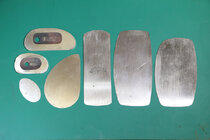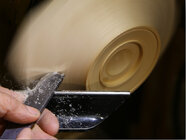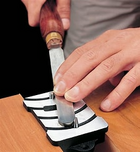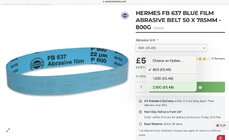Hi, as I am trying to master/understand my new veritas burr tool, I have been advised ( here ) to hone the grinder burr off and then bend a new one with the burr tool. give or take some details. While I have understood the part about getting as clean a point between the two bevels, I find it very hard to do on my french curve(ish) NRS. I'm wondering if there is a nifty trick to this, or a tool, or something. Any advise would be helpful.
Thanks
I'm not sure what you mean by
"french curve(ish) NRS". Is this something you ground yourself or bought? What does it look like from the side - sharpened like a skew or shallow angle on top, steeper angle below, curved on one edge? Please post a photo of your NRS, top and side views.
I remove the grinding burr from NRS occasionally by stropping on the flat leather wheel on a Tormek (with some honing compound applied)
However for NRS , I most often remove the grind burr with very light honing with an extra fine Eze-Lap diamond "paddle" hone (the blue one) or a ceramic hone. With the hones, I press the hone lightly between the edge with the burr and the heel of the bevel and make a gentle, smooth sweep along the edge. Shouldn't take more than one sweep. Don't raise the back side of the hone to put more angle/force on the scraping edge. You can feel for the grinding burr to assure it's all removed.
After removing the burr, I create a new burr from the bottom side with a hand-held burnisher. Doesn't take much pressure. The burr should be easy to feel with the finger/fingernail.
For card scrapers, curved or straight, I remove the grinding or sharpening burr with the same extra fine diamond diamond hone by holding it flat against the side of the scraper. Then burnish a burr.
I grind and often use curved NRS, but I'm not sure I would call them french curves. In fact, I don't think I've ever heard of a "french curve" NRS.
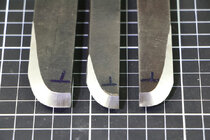

Hey, you don't mean the kind of curved card scraper on the left of this picture, do you? I've never sharpened a card scraper as NRS. (An NRS can't be flimsy for use on the lathe.)

For those, I usually cut the end off with a Dremel to make a small card scraper held between two fingers.

The whole NRS/card scraper thing could use a good document or video. I simply wouldn't know how to work effectively without them.
JKJ






